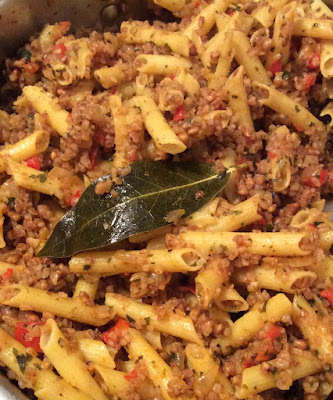It’s a pretty safe bet that most people don’t think about the
origins of the dishes they see on a restaurant menu. Diners want their food ASAP, not an etymology
lesson—although it’s not such a big leap to connect the word “Milanese” to the
city of Milan or “Bolognese” to Bologna, Italy.
Michel has invented a meatless version of the classic Bolognese Ragù, traditionally made with
ground beef and/or pork. The preservation of this sauce recipe is so important
that the Accademia Italiana della Cucina
notarized an official version in 1982 "with a solemn decree." Really.
The city of Bologna (bōh-lōh-nyah)
is known for its culinary traditions, including this well-known meat sauce that
locals refer to simply as ragù (which
explains the name of the ubiquitous sauce brand found in jars on supermarket
shelves in the US). It all comes down to
pasta with meat sauce.
The kasha part of this recipe mimics an old-school Jewish holiday
dish called "Kasha Varnishkes." Don’t be alarmed; there is no actual varnish in
the recipe. Here’s a description from a website called www.jewfaq.org
(you can’t make up this stuff):
Michel left Holland during his teens to continue his violin
studies in Rome. He lived there for quite some time and he’s traveled Italy
from top to bottom during his lifetime. He knows Italian food, clothing, cars,
films, sculpture, playwrights, paintings, music—you name it. Italy is special to Michel for very personal
reasons. From his early youth he has studied the violin makers of Cremona and
other important Italian centers for instrument making. He still spends time on a daily basis researching violin makers from Italy and beyond, and fielding questions from the people who frequently contact him to identify a particular instrument or bow.
Beyond his interest in musical things connected to the city
of Bologna, Michel has boundless respect for and utter fascination with the artist
Giorgio Morandi, who spent most of his reclusive adult life in a small apartment (with his sisters) where he made his paintings and etchings.
His depictions of seemingly mundane objects become almost abstract as
the bottles, etc., he painted again and again take on a monumentality of their
own. If you’re interested, he’s a
fascinating subject for a Google search.
In fact, President Obama chose two Morandi paintings for the White House.
Here’s just one example of a beautiful Morandi still life.
Bolognese Sauce with Kasha
You will need:
3 tablespoons olive oil
½ an onion, chopped
1 red bell pepper, chopped
½ bunch Italian parsley, chopped
5 cloves garlic, chopped
1 teaspoon dried rosemary
1 teaspoon dried sage
1 teaspoon dried fennel
1 teaspoon salt
½ teaspoon red pepper flakes
1 bay leaf
2 cups vegetable broth
Tomato paste—about 2-3 tablespoons or a bit more to taste
(Michel prefers tomato paste in a tube rather than a can.)
1 cup kasha grains
1 egg
1 box quinoa pasta—penne or shells or whatever pasta you
prefer
Grated parmesan cheese (vegans can skip the cheese or use alternate topping)
The Sauce
In a skillet or sauté pan:
Heat olive oil then add chopped onion, garlic, red pepper, and
parsley. Top with rosemary, sage, fennel, salt, pepper flakes, and bay leaf.
Let the mixture cook over medium heat for 5-7 minutes until
onion is transparent then add “a few squeezes of tomato paste” from a tube. (Michel’s measurement descriptions have been addressed
in a previous post—a good amount, a few squeezes—you know.)
Stir and let simmer while you go to work on the kasha.
The Kasha
Bring two cups vegetable broth to a boil in a small
saucepan.
While you’re waiting for broth to boil, beat the egg with
fork or whisk in a deep bowl or plastic container.
Add the kasha to beaten egg and mix thoroughly (very
important!) until grains are completely coated and egg is no longer visible, about
2-3 minutes.
Note: The egg coating allows the kasha grains to hold their
shape during cooking and creates a nutty, chewy texture. Remarkably, the result will be that the kasha will
have the appearance of chopped meat when mixed with the sauce/pasta in your
finished dish.
Transfer the egg-coated kasha grains to a dry 3-quart
skillet and stir continuously—again, very important!—over medium heat for 3-4
minutes to thoroughly cook the egg and toast the grains.
Add the boiling broth and allow liquid to cook down.
Stir in sauce mixture from sauté pan.
 |
| Looks like chopped meat, doesn't it? |
Cover and simmer while you cook your chosen pasta. Add a
little broth to the skillet mixture as needed.
The Pasta
Cook pasta to your liking.
Before you drain the pasta liquid away, add ¼ cup liquid to the kasha in
the skillet just as you would do with any pasta dish to help the sauce to
adhere to the noodles.
Drain pasta and add to kasha skillet. Stir to make sure noodles and sauce are well acquainted.
Top with grated parmesan cheese. Vegans, this is delicious without cheese too.
Buon appetito and
Happy Hannukah!

















































